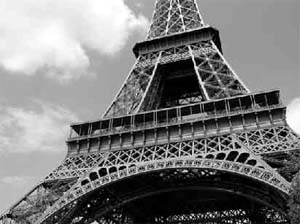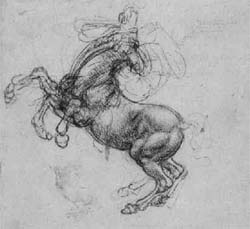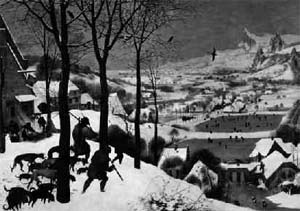In math and engineering, recursion, especially, is a big win. Inductive proofs are wonderfully short. In software, a problem that can be solved by recursion is nearly always best solved that way. The Eiffel Tower looks striking partly because it is a recursive solution, a tower on a tower.
The danger of symmetry, and repetition especially, is that it can be used as a substitute for thought.
GOOD DESIGN RESEMBLES NATURE. It's not so much that resembling nature is intrinsically good as that nature has had a long time to work on the problem. So it's a good sign when your answer resembles nature's.
Figure 9-2. Eiffel Tower, 1889. A tower on a tower.

It's not cheating to copy. Few would deny that a story should be like life. Working from life is a valuable tool in painting too, though its role has often been misunderstood. The aim is not simply to make a record. The point of painting from life is that it gives your mind something to chew on: when your eyes are looking at something, your hand will do more interesting work.
Imitating nature also works in engineering. Boats have long had spines and ribs like an animal's ribcage. In other cases we may have to wait for better technology. Early aircraft designers were mistaken to design aircraft that looked like birds, because they didn't have materials or power sources light enough, or control systems sophisticated enough, for machines that flew like birds. But I could imagine little unmanned reconnaissance planes flying like birds in fifty years.
Figure 9-3. Leonardo da Vinci, study of a rearing horse, 1481-99.

Now that we have enough computer power, we can imitate nature's method as well as its results. Genetic algorithms may let us create things too complex to design in the ordinary sense.
GOOD DESIGN IS REDESIGN. It's rare to get things right the first time. Experts expect to throw away some early work. They plan for plans to change. It takes confidence to throw work away. You have to be able to think, there's more where that came from. When people first start drawing, for example, they're often reluctant to redo parts that aren't right. They feel they've been lucky to get that far, and if they try to redo something, it will turn out worse. Instead they convince themselves that the drawing is not that bad, really—in fact, maybe they meant it to look that way.
Dangerous territory, that. If anything, you should cultivate dissatisfaction. In Leonardo's drawings there are often five or six attempts to get a line right. The distinctive back of the Porsche 911 only appeared in the redesign of an awkward prototype. In Wright's early plans for the Guggenheim, the right half was a ziggurat; he inverted it to get the present shape.
Mistakes are natural. Instead of treating them as disasters, make them easy to acknowledge and easy to fix. Leonardo more or less invented the sketch, as a way to make drawing bear a greater weight of exploration. Open source software has fewer bugs because it admits the possibility of bugs.
It helps to have a medium that makes change easy. When oil paint replaced tempera in the fifteenth century, it helped painters to deal with difficult subjects like the human figure because, unlike tempera, oil can be blended and overpainted.
GOOD DESIGN CAN COPY. Attitudes to copying often make a round trip. A novice imitates without knowing it; next he tries consciously to be original; finally, he decides it's more important to be right than original.
Unknowing imitation is almost a recipe for bad design. If you don't know where your ideas are coming from, you're probably imitating an imitator. Raphael so pervaded mid-nineteenth century taste that almost anyone who tried to draw was imitating him, often at several removes. It was this, more than Raphael's own work, that bothered the Pre-Raphaelites.
The ambitious are not content to imitate. The second phase in the growth of taste is a conscious attempt at originality.
I think the greatest masters go on to achieve a kind of selflessness. They just want to get the right answer, and if part of the right answer has already been discovered by someone else, that's no reason not to use it. They're confident enough to take from anyone without feeling that their own vision will be lost in the process.
Figure 9-4. Lockheed SR-71, 1964.

GOOD DESIGN IS OFTEN STRANGE. Some of the very best work has an uncanny quality: Euler's Formula, Bruegel's Hunters in the Snow, the SR-71, Lisp. They're not just beautiful, but strangely beautiful.
I'm not sure why. It may just be my own stupidity. A can opener must seem miraculous to a dog. Maybe if I were smart enough it would seem the most natural thing in the world that eip = -1. It is after all necessarily true.
Most of the qualities I've mentioned are things that can be cultivated, but I don't think it works to cultivate strangeness. The best you can do is not squash it if it starts to appear. Einstein didn't try to make relativity strange. He tried to make it true, and the truth turned out to be strange.
At an art school where I once studied, the students wanted most of all to develop a personal style. But if you just try to make good things, you'll inevitably do it in a distinctive way, just as each person walks in a distinctive way. Michelangelo was not trying to paint like Michelangelo. He was just trying to paint well; he couldn't help painting like Michelangelo.
The only style worth having is the one you can't help. And this is especially true for strangeness. There is no shortcut to it. The Northwest Passage that the Mannerists, the Romantics, and two generations of American high school students have searched for does not seem to exist. The only way to get there is to go through good and come out the other side.
Figure 9-5. Bruegel's Hunters in the Snow, 1565.

GOOD DESIGN HAPPENS IN CHUNKS. The inhabitants of fifteenth century Florence included Brunelleschi, Ghiberti, Donatello, Masaccio, Filippo Lippi, Fra Angelico, Verrocchio, Botticelli, Leonardo, and Michelangelo. Milan at the time was as big as Florence. How many fifteenth century Milanese artists can you name?
Something was happening in Florence in the fifteenth century. And it can't have been genetic, because it isn't happening now. You have to assume that whatever inborn ability Leonardo and Michelangelo had, there were people born in Milan with just as much. What happened to the Milanese Leonardo?
There are roughly a thousand times as many people alive in the US right now as lived in Florence during the fifteenth century. A thousand Leonardos and a thousand Michel Angelos walk among us. If DNA ruled, we should be greeted daily by artistic marvels. We aren't, and the reason is that to make Leonardo you need more than his innate ability. You also need Florence in 1450.
Nothing is more powerful than a community of talented people working on related problems. Genes count for little by comparison: being a genetic Leonardo was not enough to compensate for having been born near Milan instead of Florence. Today we move around more, but great work still comes disproportionately from a few hotspots: the Bauhaus, the Manhattan Project, The New Yorker , Lockheed's Skunk Works, Xerox Parc.
At any given time there are a few hot topics and a few groups doing great work on them, and it's nearly impossible to do good work yourself if you're too far removed from one of these centers. You can push or pull these trends to some extent, but you can't break away from them. (Maybe you can, but the Milanese Leonardo couldn't.)